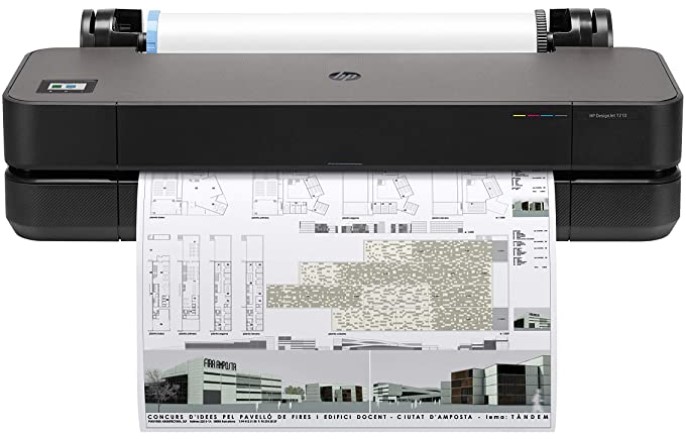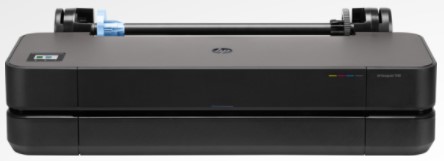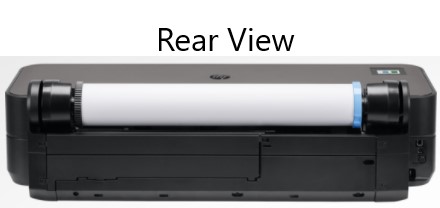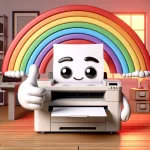
The HP DesignJet T210 is one of their latest large format printers. Designed for smaller engineering or architect drawings, it is also great for presentations, maps, or color posters. This desktop plotter prints on a 24 inch paper roll, though it can still print 24 x 36 inch drawings.
Cut sheets are feed one sheet at a time. There is an optional cut sheet tray to hold more sheets if you need to use a lot of cut sheet paper.
Similarly featured and priced plotters will be compared in this review. The weaknesses and advantages among them will be explored. Ultimately informing your decision about which plotter would be a good fit for your needs.
Based on my experience servicing plotters, the T210 should is a solid performer. Previous models, such as the T130, have had few issues. HP plotters are usually very reliable.
Service calls I’ve done on this model so far have been for typical maintenance such as replacing a print head or the odd warranty call. Warranty calls don’t tell much about the reliability of a printer. Any new printer can occasionally see a sensor or power supply fail.
Why This Plotter?
Why someone would want this plotter is because they are looking for an inexpensive solution to printing engineering, architectural, technical drawings, maps, or color posters.
If you have a need for color maps, graphs, or posters the HP DesignJet T210 would be an obvious choice.
Many plotters are B&W only since they use a laser process (Although KIP makes a color laser plotter). This plotter uses a color inkjet process (and costs only a fraction of the KIP).
While the HP DesignJet T210 has excellent quality, HP has a different series of wide format for high quality graphic designs, artwork, or those type of color projects.
For fine lines, small text, and numbers found on most engineering drawings an inkjet with coated paper can be better than a laser process.
This is a magnified image comparing inkjet and laser printer output. On the left is an inkjet printer on coated paper. The right is from a laser printer.


Why someone would want this plotter is because they’re looking for one that’s easy to use. Printing to a wide format printer may not always be an easy process. There are usually a few more steps involved than a typical printer due to the scaling and layout.
HP’s simpler process and streamlined print driver stands out for its ease of use. For an even simpler way to print, HP Click software is able to print files via drag and drop.
Why someone would consider this plotter:
- To print engineering drawings
- Need some color printing
- Easy to use and setup

Comparable Products
If you’re shopping for a wide format inkjet printer in this range the Canon prograf TA-20 or the Epson Surecolor T2170 are probably printers being considered also. While the Canon is somewhat higher priced, they all have similar features.
The HP, Canon, and Epson have similar connectivity options, ink costs, and print speeds. The Canon is the fastest, that is if any wide format printer can be considered fast.
They all take 24 inch paper rolls but the HP will accept the thickest paper (11.8 mil). Compared to 8 mil of the other two. Which is adequate for most paper rolls. It may only be a concern printing on heavy canvas or vinyl.
While these plotters don’t come with stands, optional ones are available. Canon’s stand option costs a little more than the ~$250 stands from HP or Epson.
Since they will be taking up valuable table top space in an office, dimensions are relevant. I tested the weight and dimensions with a standard scale and ruler.
I weighed HP DesignJet T210 at 48 lbs. My measurements revealed a width of 40 inches, a depth of 18 inches, and a height of 11.5 inches. A fairly light plotter which is about the size of 3 desktop printers side by side.
All these desktop plotters are much more compact than ones using a laser process. The HP takes up the least space of the three. With the Epson a close second. The Canon not only has an odd cylindrical shape but also takes up much more depth than the others.
Canon Comparison
One difference with the Canon prograf TA-20 is it has 5 colors. In addition to cyan, magenta, yellow, and black Canon includes a matte black. Engineering drawings, maps, and line drawings in general are better with matte black ink. Which is one of the 4 colors of the HP DesignJet T210.
The extra color may slightly improve color charts or graphs but not so much with the drawings I’ve seen from the Canon.
While the Canon uses all pigment inks, the HP uses dye based ink for brighter colors (C/M/Y) and pigment black (matte) for durability.
While Canon’s ink is .05 cents lower per liter, this difference may be less than a hundred dollars over the life of the plotter. The lower initial price of the HP would more than make up the difference.
Perhaps it’s not that important but the overall shape of the Canon is round. When I’ve added ink cartridges to the Canon there’s nowhere to set anything. Everything slides off the top.
It’s common to take a fresh print from the exit bin and place it on top of the printer to examine. The large print can easily get sucked back into the Canon plotter.

Epson Comparison
The Epson’s initial price is slightly lower than the HP. Epson’s ink cost per liter is also lower than the HP as well. The .09 cents per liter difference may be cancelled out by HP’s sparse use of ink. HP uses much less ink on maintenance cycles than previous models.
The Epson has the standard 4 color pigment inks though they doesn’t use matte black. It’s print quality is arguably better than the others but matte black ink does look better for engineering drawings.
The Epson would do well with posters, maps, or graphs. Though artwork or graphic designs would be better served by a presentation series of wide format printers.

Benefits and Drawbacks
HP really makes printing to this plotter easy. There is one click printing from a smartphone. Although I don’t think anyone is using a smartphone to print CAD drawings. It may come in handy for posters or graphs.
HP’s job submission software, “HP Click”, is included with this plotter. For freeware it is fairly useful. I send all my test pages using HP Click.
Instead of opening a program or app to print, HP Click has drag and drop printing. A great way to print PDF, JPEG, TIFF, DWF, HP-GL/2, and PNG files.
You can use the defaults or set your own job parameters, then drop a file to be printed. Setting up HP Click is as simple as entering the plotters IP address.
Streamlined print drivers have eliminated a few steps if you’d rather print that route.
For Mac users, there isn’t a specific PPD from HP yet. A generic or previous model PPD will have to be used.
HP improved the ink usage during maintenance cycles from previous models.
Starting the new roll is easier than ever. Not that putting it on the spindle is easy for any plotter, just that feeding that initial edge seems to happen with less issues.
I had fewer errors, beeps, or long periods of waiting when loading a new roll. Even when I get an unsuccessful or skew message, it clears without a struggle.
On one hand the cutter is technically a service item for the HP DesignJet T210. On the other hand I only had to remove one screw and a cover to access the cutter. Which snaps in. If you didn’t call a tech to replace it we’d get over it.
Besides, cutters last a very long time in my experience. Some last as long as the plotter itself. Frequent use of canvas or heavy material may wear them out quicker. Epson and Canon consider the cutter an end user item.

Deciding Factors
What the HP has going for it is ease of use, versatile media options, and fine line quality. From the print apps to adding paper this plotter is among the easiest to use.

The Copier Guy, aka Dave. I’ve worked on scanners, printers, copiers, and faxes since 1994. When I’m not fixing them I’m writing about them. Although, I’m probably better at fixing them. I’ve worked with every major brand. As well as several types of processes. If it uses paper I’ve probably worked on one.





